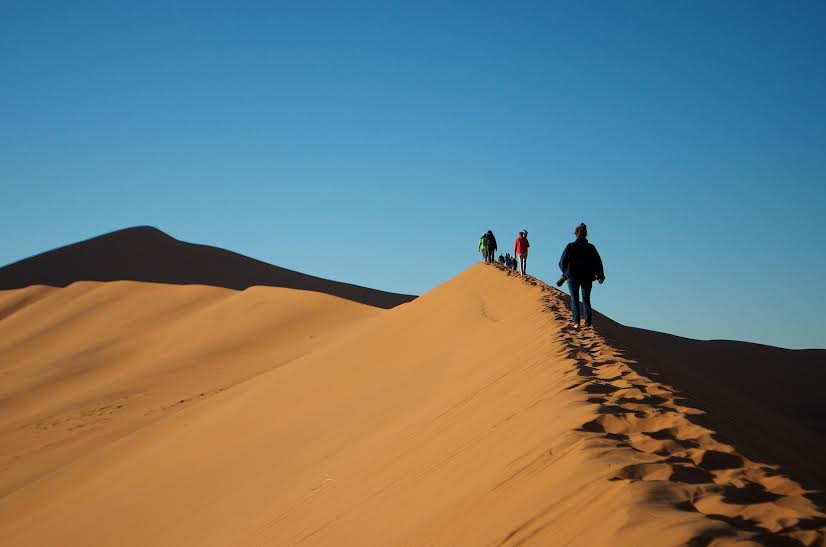
You might also like:
Namibia Tourism
Here’s how Namibia is nailing sustainable tourism:
Namibia was the first African country to incorporate the protection of the environment into its constitution.

Namibia Tourism
In addition to the local community’s involvement with sustainable activities, many are also employed as Conservation Guards to protect wildlife from poachers. Because of this, REI presented the Namibian Conservation Guards the 2013 Sustainable Tourism Award, which gifted 500 guards with backpacks of gear and supplies to support and encourage their work with Namibia’s conservation.
Almost an eighth of Namibians are involved, with registered conservancies covering more than 18% of the country with an additional 19% of the land being protected in national parks and sanctuaries. Namibia was also the first African country to integrate environmental protection into its constitution.
The outcome? The country is now home to a quarter of the world’s total cheetah population. Not to mention, in a region of the country where black rhinos were almost extinct thirty years ago, there now exists the largest number of free-roaming black rhino in the world.
There are enough sustainable activities to fill your entire trip.

Namibia Tourism
Properly managed tours offer visitors education, involvement, and cultural awareness, which results in respect and income for local communities.
With local guides, visitors can tour Brandberg, Namibia’s tallest mountain, and its 2,000 year-old rock paintings; the 280-million-year-old trunks from the petrified forest; or the rock engravings of Twyfelfontein. Whichever you choose, if you go with a community-based tour, you’re contributing to this positive cycle that involves tourists as well as locals.
Another activity is sandboarding with Alter Action — Namibia’s first company to use snowboards to train people how to safely board down the massive dunes of Swakopmund. Hitting speeds of 72 kph down a 100-meter tall dune? There’s nothing quite like it. And as long as you leave no trace, it’s a completely ecofriendly and non-motorized activity. This includes no lifts to the top, which means boarders have to carry their gear up the dunes as many times as they want to go down.
There’s also Swakopmund Fat Bike Tour, which is the most ecofriendly way to explore the Namib Desert. With tires like balloons and wider contact area to distribute weight more evenly, the non-motorized Fat Bike’s tracks are actually more shallow than footprints.
Namibia is quickly gaining recognition as a leader in responsible travel.

Namibia Tourism
Namibia hosted the fifth Global Partnership for Sustainable Tourism conference in 2015, which encourages the healthy balance of sustainability and tourism. GPST credited Namibia as becoming one of the world’s leading destinations striving for a more successful blend of conservation, tourism, and the development of Namibian communities.
One of the many reasons for Namibia’s tourism growth is the recognition and sustainable reputation the country has gained throughout the years leading up to this award. According to the Namibian Sun, for every 12 tourists that arrive in Namibia, one job is created in addition to about 27% of all jobs being affiliated with the travel and tourism industry. This creates a more accessible opportunity for Namibians to receive training and further education to contribute to this important and positive tourism growth.
Their idea of cultural tourism feels responsible and respectful, not exploitive.
Cultural tourism is a way for travelers to absorb local rituals and unique customs. This encourages local communities to embrace and celebrate their own cultures and practices. The end result is economic growth paired with authentic and appropriate interactions between locals and visitors.
For example, Namibia is home to the Herero tribe, who are characterized by their heavy, hand-sewn Victorian-style dresses and horn-shaped headgear. Prideful of their outfits with colorful patterns, Herero women often sell dolls in traditional Herero attire at roadside markets. By stopping to buy one of these dolls or other hand-made crafts, the Herero tribe is supported economically as well as their culture and heritage being embraced by visitors.
Then there’s the semi-nomadic Himbas, who are recognized by their bare chests, clothing made from calf skins, and their otjize paste-covered skin — a mix of butterfat and red ochre. One way to experience true Himba culture is to go on a village tour, which introduces you to villagers as they complete their daily routines. Since responsible tour operators work together with the Himbas on these experiences, it’s an authentic opportunity to be painted with ochre and smell their deodorising perfume in a traditional Himba hut as well as learn about their traditions and rituals. Responsible tour operators also pay the Himbas with goods such as sugar and bread in addition to visitors having the chance to purchase jewelry and other crafts at the end of the tour.
And then there’s the Eco Awards Namibia.
Need help finding a sustainable lodge or hotel? Have fun sorting through the 60 eco-establishments listed on the Eco Awards website.
Eco Awards Namibia is one of the best ways to tell if an establishment is sustainable. If an establishment receives an Eco Awards desert flower certificate, then visitors know the place has eco-friendly and responsible values. This program promotes the reduction of waste and the habit of recycling and reusing, which grows the establishment’s popularity and profitability. Explore Namibia knowing you are not leaving a giant, nasty footprint.
Source: matadornetwork.com
